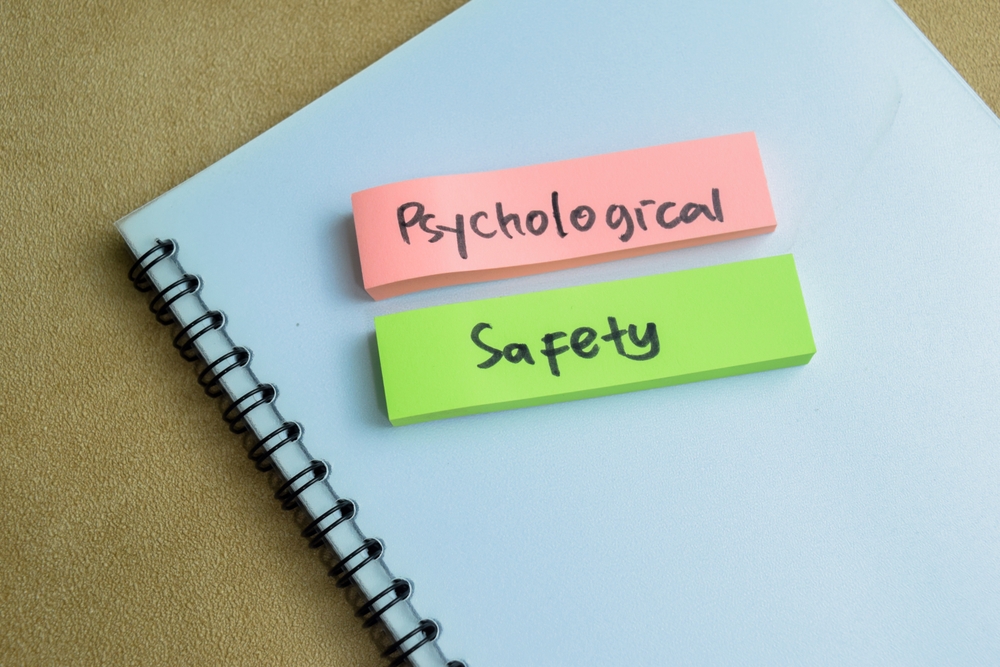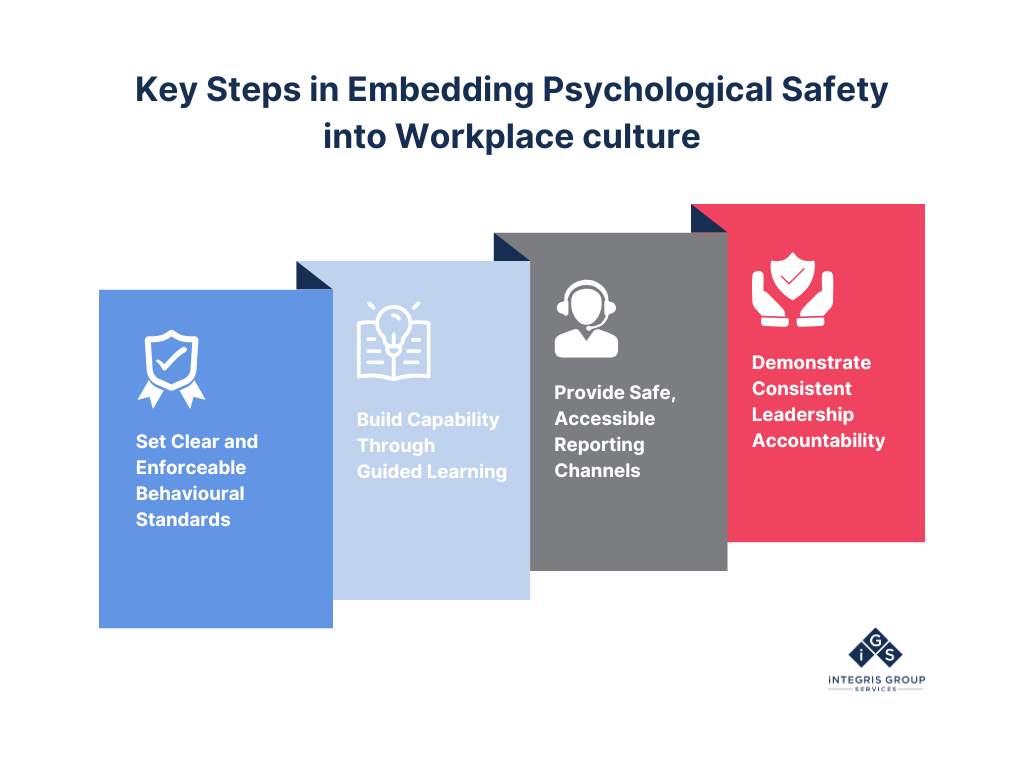
Psychological Safety in the Workplace
Is your workplace truly safe, not just physically, but psychologically too?
As our understanding of workplace health and safety continues to evolve, it is increasingly recognised that psychological wellbeing is just as vital as physical safety. Employees need more than protective equipment or aspirational slogans. They need psychologically safe workplaces where they feel respected, supported, empowered, and safe.
A recent case involving Oz 22 Painting Pty Ltd has drawn attention to the growing importance of psychological safety at work in Australia. This case presents a valuable opportunity for leaders to reflect on how they are shaping their organisational culture. Psychological safety in the workplace is not simply a compliance issue, it is a leadership responsibility grounded in care, ethics, and the long-term health of the organisation.
Why Psychological Safety Matters

Psychological safety involves cultivating an environment where people feel confident to speak up, raise concerns, and contribute without fear of ridicule, exclusion, or retribution. It underpins high-performing teams, ethical leadership, and sustainable business outcomes.
In the case of Oz 22 Painting Pty Ltd, a worker reported inappropriate and persistent behaviour by a senior individual in the business. An investigation found the company had no behavioural policies or reporting mechanisms to support the worker. The court subsequently determined that the business had breached its obligations under psychological safety legislation and broader workplace health and safety laws.
This outcome reinforces the responsibility of all organisations, regardless of size or sector, to foster psychologically safe environments. It also highlights a deeper challenge. When leadership itself is the source of unsafe behaviour, the absence of governance mechanisms may leave workers exposed. While no policy can guarantee the prevention of misconduct, putting robust structures in place sends a powerful signal to the organisation and its team members: showing that employee wellbeing is a priority, and that leadership is accountable.
Embedding clear expectations and response mechanisms reflects the seriousness with which an organisation treats its duty of care. Much like the fiduciary duties a director holds, a commitment to psychological safety frameworks embeds a culture of responsibility and mindfulness. This increases the likelihood that power is exercised ethically and transparently.
Embedding Psychological Safety into Workplace Culture
Creating a psychologically safe workplace goes beyond compliance. It is about operationalising values such as respect, empathy, and integrity into the way business is conducted every day. Leaders can take several practical steps:

1. Set Clear and Enforceable Behavioural Standards
Develop and communicate policies that define respectful and inclusive conduct. These should clearly outline behaviours such as bullying and harassment, as well as responsibilities for prevention and intervention. Importantly, policies must be accessible, reinforced regularly, and supported by consistent enforcement.
Learn more about business assurance and workplace safety management.
2. Build Capability Through Guided Learning
Equip leaders and team members with the knowledge and skills to promote and protect psychological safety. Guided learning approaches — including psychological safety courses and role-based training — can deepen understanding and reinforce behavioural expectations over time.
Explore more on learning and development for psychological safety.
3. Provide Safe, Accessible Reporting Channels
Confidential and trusted reporting mechanisms are essential. These may include internal HR contacts, external support services, or independent hotlines. It is equally important that follow-up processes are clear, fair, and consistently applied, so employees feel confident that concerns will be taken seriously.
Learn more about employee engagement and development, and how to extend care within your team.
4. Demonstrate Consistent Leadership Accountability
Psychological safety at work starts with leadership. When senior figures model respectful behaviours, listen actively, and respond constructively to concerns, it sets a standard that resonates across the organisation. Equally, when breaches occur, timely and principled responses are critical in rebuilding trust.
Explore more about the power of values-driven leadership.
The Broader Benefits for Organisations
Investing in psychological safety contributes to stronger, more resilient organisations. Benefits include:
These outcomes create a culture where employees feel valued and empowered, and where the organisation is positioned to respond effectively to both challenges and opportunities through a structured psychological safety framework.
Looking Ahead: Shaping a New Standard

The Oz 22 Painting case, while concerning, represents a broader shift in how workplace responsibilities need to be understood. It demonstrates that psychological safety in the workplace is becoming a central pillar of workplace standards, not just in corporate settings, but across all sectors — from trades and services to community care and education.
This shift is also echoed in broader leadership discussions. In his widely viewed talk on generational expectations and leadership, Simon Sinek highlights the importance of creating environments where people feel safe, valued, and trusted. While not focused on psychological safety legislation, his message reinforces a critical truth: strong leadership requires intention, empathy, and a willingness to build systems that support human wellbeing.
Organisations now have the opportunity, if not a responsibility, to lead with clarity and compassion, setting standards that go beyond compliance. By doing so, they help shape environments where people can thrive, not just survive. The future of work demands leadership that prioritises psychological safety, dignity, and trust.
At Integris Group Services, we help organisations turn these expectations into action. From developing clear policies to delivering guided learning for organisations in how to create a psychologically safe work environment, we work alongside leaders to embed values-driven, psychologically safe practices into their everyday operations.
Ready to lead with integrity?
Let’s talk about how your organisation can become a model for psychological safety at work in Australia — a place where everyone can thrive.
FAQs
What is psychological safety in the workplace and why is it important?
Psychological safety in the workplace is the belief that individuals can express themselves, raise concerns, and contribute ideas without fear of embarrassment, punishment, or retaliation. It plays a vital role in creating a culture of open communication, inclusion, and trust. When psychological safety is present, employees are more engaged, collaboration improves, and organisations are better equipped to respond to challenges and change. Importantly, psychological safety also supports compliance with workplace health and safety laws, particularly in high-risk or people-focused environments. For employers, it is not only a best practice but a strategic advantage that contributes to productivity, innovation, and reduced risk.
Do small businesses need psychological safety policies and training?
Psychological safety is just as important for small businesses as it is for larger organisations. In fact, smaller teams often rely more heavily on interpersonal dynamics, making it even more critical to establish clear boundaries and expectations. Without formal policies or structured training, small business owners may unknowingly create environments where employees feel unsafe to speak up or report concerns. Implementing psychological safety policies and guided learning programs helps to build a culture of respect and accountability. It also demonstrates a proactive approach to employee wellbeing and legal compliance, reducing the likelihood of workplace issues escalating into formal complaints or reputational harm.
How can an organisation create a psychologically safe workplace culture?
Creating a psychologically safe workplace begins with a clear commitment from leadership. Organisations should start by introducing workplace behaviour policies that set expectations for respectful and inclusive conduct. These policies need to be consistently reinforced and supported by fair, confidential reporting mechanisms that employees trust. Equipping teams with guided learning focused on psychological safety is essential, as it helps employees and leaders understand their roles in shaping a supportive culture. Over time, when people see that their wellbeing is taken seriously and that concerns are acted upon, trust grows, communication improves, and the workplace becomes more inclusive, productive, and compliant with regulatory obligations.
One approach to establishing a psychologically safe workplace is to establish a psychological safety framework or management system, as introduced in our course here.
Reference:
[i] https://www.safeworkaustralia.gov.au/doc/model-code-practice-how-manage-work-health-and-safety-risks
